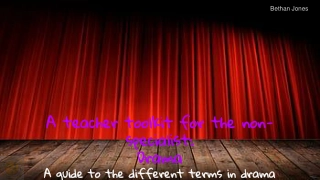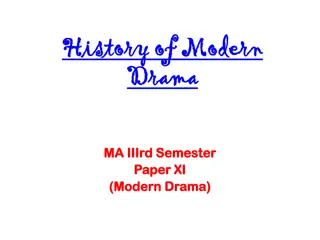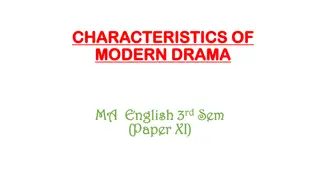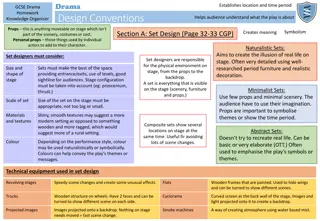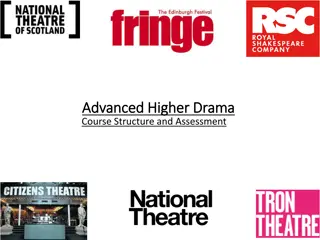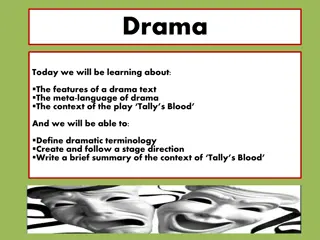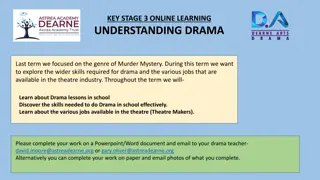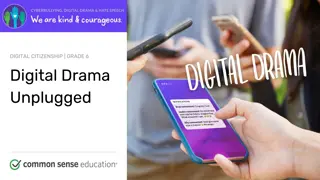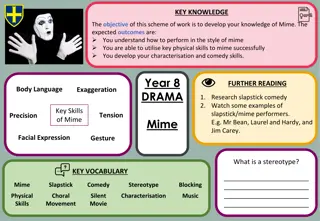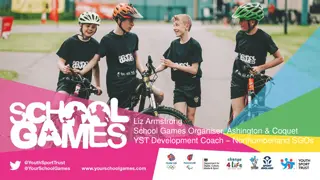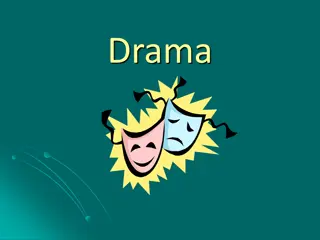Devising Drama - GCSE Knowledge Organiser
This GCSE Drama Knowledge Organiser provides guidance on devising and performing an original piece of theatre based on a stimulus. It covers how to respond to stimuli, develop ideas for theatrical performances, apply theatrical skills, analyze and evaluate work, and rehearse and refine the devised piece. Students are encouraged to engage in storytelling games, research, explore character development exercises, and use various drama techniques. The resource emphasizes understanding dramatic structure, performance styles, genre, and dramatic intention. It aims to enhance students' creativity, teamwork, and critical thinking in the field of drama.
Download Presentation

Please find below an Image/Link to download the presentation.
The content on the website is provided AS IS for your information and personal use only. It may not be sold, licensed, or shared on other websites without obtaining consent from the author.If you encounter any issues during the download, it is possible that the publisher has removed the file from their server.
You are allowed to download the files provided on this website for personal or commercial use, subject to the condition that they are used lawfully. All files are the property of their respective owners.
The content on the website is provided AS IS for your information and personal use only. It may not be sold, licensed, or shared on other websites without obtaining consent from the author.
E N D
Presentation Transcript
DRAMA GCSE DEVISING aclarke@nottinghamfreeschool.co.uk Knowledge Organiser Devising Drama Work as part of a group. Create and perform an original piece of theatre based on a stimulus. Evaluate your piece of theatre. Know your course: Section A: AO s and how to respond to a stimulus. Create and develop ideas to communicate meaning for theatrical performance AO1 Devising log 60 marks 20% of GCSE Performance 20 marks 20% of GCSE Apply theatrical skills to realise artistic intentions in live performance AO2 Analyse and evaluate your own work and the work of others AO4 1. Responding to a stimulus. You always use a stimulus as a starting point for devising drama. A stimulus is something that is used to provoke your thinking and get your ideas flowing. When looking at a stimulus, always think about: Your very first impressions of it. What does it make you think/feel, if anything? Does it bring up any memories for you? Does it suggest any particular time period or setting? Does it suggest or make you think of any themes? 2. EXAMPLE: A school sports day may make you think of the themes of competition or childhood. Using the knowledge you have learnt above, have a go at applying it to the stimuli on this page. For each one, create a small section on a page in your workbook and work through the 4 bullet points above for each one. I will be checking your workbook to make sure you have had a go at developing this knowledge by putting it into action. 3. 1
DRAMA GCSE DEVISING aclarke@nottinghamfreeschool.co.uk Year 10 Knowledge Organiser Devising Drama Work as part of a group. Create and perform an original piece of theatre based on a stimulus. Evaluate your piece of theatre. Section B: Devising Log 2
DRAMA GCSE DEVISING aclarke@nottinghamfreeschool.co.uk Knowledge Organiser Devising Drama Work as part of a group. Create and perform an original piece of theatre based on a stimulus. Evaluate your piece of theatre. One word story, word association, creative writing in response to stimulus Section C: Developing your ideas and research Page 44-47 CGP Storytelling games help to inspire ideas Pg 45 CGP Research is really important, as it helps you develop your initial ideas. You must research your stimulus in different ways: -Use books -Use the internet -Speak to people at home and at school -Watch films or TV programmes related to it or the ideas you have developed from the stimulus. Explore character development exercises See KO Section F Hot seating Role on the wall Conscience Alley Park bench Use drama techniques and conventions to help develop your piece Flashback, flashforward, tableau, freeze frame, aside, soliloquy, slow motion, improvisation Your research should also involve investigating current trends and themes as well as any issues or controversies from the time when the stimulus was created. Artaud, Boal, Brecht, Stanislavski, Berkoff DV8 Frantic Assembly Be inspired by other companies and practitioners KO Section G EXAMPLE an article about climate change could lead you to look at websites for environmental charities where you might find real life stories to use as inspiration or to incorporate them in some way into your devised piece. Naturalism, physical theatre, epic theatre, forum theatre Pick a performance style Comedy, tragedy, melodrama Think about genre Dramatic Aim and Intention See KO Section D Dramatic Structure OPENING BUILD UP CLIMAX - RESOLUTION 3
DRAMA GCSE DEVISING aclarke@nottinghamfreeschool.co.uk Knowledge Organiser Devising Drama Work as part of a group. Create and perform an original piece of theatre based on a stimulus. Evaluate your piece of theatre. Section C cont....: Rehearsing and Refining Page 48-49 CGP Rehearsal Diary Meet devising log section deadlines Make sure you are on top of keeping notes about how you developed and refined your ideas. Do this in your GREEN book in class. Refer back here throughput the process... A script can help develop dialogue How is your character development work going? Are you using Vocal and Physical performance skills consistently? A Few Reminders... Rehearsal Schedule Keep a close eye on the rehearsal schedule I gave you. Make sure you and your group are on track. Leave enough time to prepare for your performance Use lesson time to develop and refine work aclarke@nottinghamfreeschool.co.uk Are you achieving your dramatic aims and intentions? 4
DRAMA GCSE DEVISING aclarke@nottinghamfreeschool.co.uk Knowledge Organiser Devising Drama Work as part of a group. Create and perform an original piece of theatre based on a stimulus. Evaluate your piece of theatre. Section D. Statement of Dramatic Intent It is very helpful to write this towards Example: In the performance, I aim to show that loneliness can be a very debilitating thing for anyone. I want the audience to sympathy for the lonely character in the piece but I also want the audience to feel like they can relate to that character and realise that it could quite easily be them. Not only that, I want to deliver the message that despite what a person shows on the outside, they can be suffering on the inside and that responsibility to check up on friends, family and neighbours to make sure they are ok. I want the audience to leave thinking about others and how they can go out into their community and help others. Writing a Statement of Dramatic Intent: Think about what effect you want to have on the audience. How do you want the audience to react to your piece? EG with sympathy, admiration, shock, tension or amusement. Do you want your piece to have an overall message or moral? EG you may want to challenge the audience s views about something or persuade the audience to think a certain way about something. the start of the devising process, as it will help you make decisions about feel a lot of what the message of your piece is and what performance style you will use. This in turn will then help you pinpoint the theatre conventions that are aligned with your chosen performance it is society s style and therefore that may work well in your piece. It is a justification of your theatrical choices (approximately 150 words) In your workbook: have a go at writing a Statement of Dramatic Intent for your devised piece. Which -Performance style -Theatre Conventions may work for this piece in order to deliver the aims of this statement of dramatic intent? In the performance I aim to show In this performance I want the audience to 5
DRAMA GCSE DEVISING aclarke@nottinghamfreeschool.co.uk Knowledge Organiser Devising Drama Work as part of a group. Create and perform an original piece of theatre based on a stimulus. Evaluate your piece of theatre. Section F: Section E: Checklist for devising Characterisation checklist Page 20-23 CGP Performance Skills You need to use your performance and devising log to show the examiner that you: Can work collaboratively with other people Have a good understanding of style, genre and theatrical conventions. Are creative and imaginative Can fulfil the aims you set out to achieve when creating your piece. Can evaluate your own work. Have developed skills as either a performer or a designer. This is the way a performer interprets and performs their character. 1. 2. Rehearse and learn lines Adapt and improve performance with feedback. Use vocal performance skills. Use physical performance skills. Use characterization. Communicate with the audience and other performers. Dialogue and stage directions as well as the performer's own thoughts and interpretations of what the character is like are crucial. 3. 4. 5. 6. Design Skills Characterisation has an impact on the audience. THINK about how you want the audience to respond to your character (sympathise with, hate, love, scared of?) 1) Make appropriate judgements during the development process. Create clear and practical designs with thought given to how you will actually apply the design (materials etc) Adjust designs in response to rehearsals Use design element to create mood, atmosphere and style. Use design skills during a performance. 2) Character Status Protagonist main character and the plot follows their experiences and character development. Antagonist causes trouble for the protagonist and usually disliked by the audience. Minor character important to the plot but not the audience's main focus (eg: Linda in Blood Brothers) 3) 4) Context historical and social context. When and where a play is set will affect how a character acts and reacts in certain situations. 5) Rehearsal techniques for characterisation: Method acting, hot seating, status games, defend a character, conscience alley, role on the wall. Stock character: instantly recognisable as a stereotype. 6
DRAMA GCSE DEVISING Knowledge Organiser Devising Drama Work as part of a group. Create and perform an original piece of theatre based on a stimulus. Evaluate your piece of theatre. Section G: Theatre Practitioners 2. Bertolt Brecht: He was a pioneer of political theatre and believed drama should educate. He founded the alienation technique (Verfremdungseffekt) Brecht broke down the illusion of the Fourth Wall by distancing audiences from the action and preventing their emotional involvement with the characters. He created Epic Theatre with songs, explanatory placards, unnatural lighting, projection screens, spoken stage directions, use of narration and the actors directly addressing the audience. 1, Constantin Stanislavski: A pioneering actor and director who brought naturalism to the stage. He believed actors should research scripts and relate to their character s motivations by delving into their own emotions. Pioneered The Method and believed actors should fully inhabit the role they are playing both on and off stage. Actors should know all of their dialogue, movement and motivation for this on stage, but they should also have a detailed understanding of their character s life offstage, as this will improve their performance and make it more naturalistic. The magic IF Actors to ask themselves What would I do if to help them create believable characters in all situations. https://www.bbc.co.uk/bitesize/guides/zxn4mp3/revi sion/1 Remember: there are no small parts, only small actors. 3. Augusto Boal: Founded the Theatre of the Oppressed He developed lots of warm ups and games for actors which has influenced the development of Theatre In Education. Forum Theatre audience members can stop the performance and suggest alternative actions. 4. Antonin Artaud: Regarded as inspirational in Experimental Theatre and Performance Art. He created the Theatre of Cruelty an experience that pushed the audience s feelings to such an extreme, it was almost painful. He rejected realistic dialogue in favour of Total Theatre using movement, lighting and sound. He imagined the audience imprisoned by the action and experimented with audience positioning. Great practitioner information and revision tools at: 7 https://www.bbc.co.uk/bitesize/topics/zm72pv4
DRAMA GCSE DEVISING aclarke@nottinghamfreeschool.co.uk Knowledge Organiser Devising Drama Work as part of a group. Create and perform an original piece of theatre based on a stimulus. Evaluate your piece of theatre. Section H. Performance styleThis is how the drama is performed in what way or style. 1. Naturalism CONSTANTIN STANISLAVSKI A style of theatre that aims to recreate real life on stage. Can also be known as realism. Every aspect of the performance has to be believable including set, costume, sound and lighting. Theatre makers want the audience to suspend their disbelief and be fully entertained by what s happening on stage. To maintain the illusion, the performers cannot break the fourth wall or interact with the audience. They must stay in character at all times. suspend their disbelief The audience know that what they are seeing on stage is pretend but they are willing to ignore that fact for the sake of enjoyment. fourth wall imaginary barrier that separates the audience from the action on stage. Alienation Effect 2. Non-naturalistic Epic Theatre BERTOLTBRECHT Opposite of naturalism it aims to distance the audience from the story by reminding them it isn t real. This encourages the audience to focus on the play s message or moral. Performance techniques are used to remind the audience they are watching a play and this is called the alienation effect The techniques mentioned enable the audience to focus on the (usually political) message of the play. Break the fourth wall using: NARRATION A NON-LINEAR STRUCTURE MINIMAL SET AND PROPS Mixture of comedy and then serious issues combined. Unnatural lighting Placards Projection screens Spoken stage directions 3. Experimental Theatre and Theatre of Cruelty ANTONIN ARTAUD It aims to make the audience think AND shock them into feeling extreme emotions. This style of performance should assault the audience s senses with a combination of bright lights, loud sound effects and striking movements and gestures. Artaud felt these techniques were more effective than dialogue. PTO 8
DRAMA GCSE DEVISING aclarke@nottinghamfreeschool.co.uk Knowledge Organiser Devising Drama Work as part of a group. Create and perform an original piece of theatre based on a stimulus. Evaluate your piece of theatre. Section H: Performance style cont 3. Experimental Theatre and Theatre of Cruelty ANTONIN ARTAUD This style also experiments with performer / audience relationship. Artaud wanted the audience sat in an empty room in the middle of the space with the action of the play going on around them. He only ever applied this configuration with one of his plays (Le Cenci 1935) and it was a complete failure. This emphasised the importance of the audience for a production. If a play is too violent, unpleasant or uncomfortable, an audience simply will not watch it and the theatre maker cannot get there message across. 5. Theatre of the Oppressed AUGUSTO BOAL Audience are to take an active role in the action rather than being passive spectators. A range of techniques get the audience involved: 1. Invisible Theatre putting on a performance in public but disguising it as real life. The idea is that the audience would chose to intervene in the action without actually realising what was happening. 2. Forum Theatre A short play showing injustice of some sort is performed twice. During the second performance, the audience is expected to stop and alter the action to create a different outcome for the characters. It is thought that by having the audience interact with the action in this way, they will then feel empowered to make a difference in real life situations. Several theatre companies use these techniques to try and bring about positive change and raise awareness of key issues. 6. Physical Theatre Frantic Assembly, DV8 A style which uses choreographed movement and dancing to tell a story. These movements can be combined with traditional dialogue or used on their own. Minimal set and props are used so that the audience can focus on the physical action. Sometimes the actors bodies are used as objects onstage. There is nothing realistic about this way of movement and so this style can be associated with Brecht and Artaud. Performers can communicate emotion to the audience that would be difficult to convey using dialogue. 9
DRAMA GCSE DEVISING aclarke@nottinghamfreeschool.co.uk Knowledge Organiser Devising Drama Work as part of a group. Create and perform an original piece of theatre based on a stimulus. Evaluate your piece of theatre. GENRE: This is the type of story a performance tells. Section I Form and Genre FORM: TRAGEDY COMEDY DOCUDRAMA MELODRAMA This is the type of drama decided by the playwright. PLAY MUSICAL MIME MONOLOGUE The genre you choose will influence the structure and ending of your piece. STYLE: For the purpose of devising, the FORM you will most likely choose, will be a PLAY (scripted dialogue between characters.) This is the how the drama is perfromed NATURALISM PHYSICAL THEATRE NON NATURALISM - EPIC THEATRE FORUM THEATRE THEATRE OF THE OPPRESSED You may choose to add elements of MIME and/or a short MONOLOGUE as theatrical conventions if it is relevant to your piece. You must use theatrical conventions that are linked with the style you choose and reference the work of the associated practitioner. 10
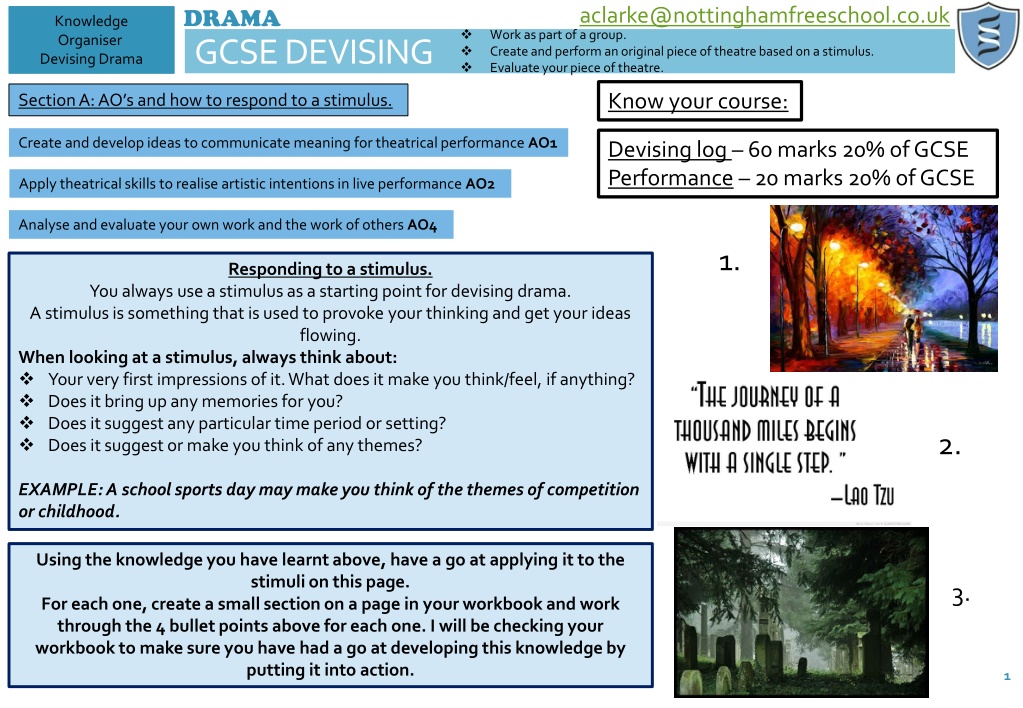
 undefined
undefined













 undefined
undefined





